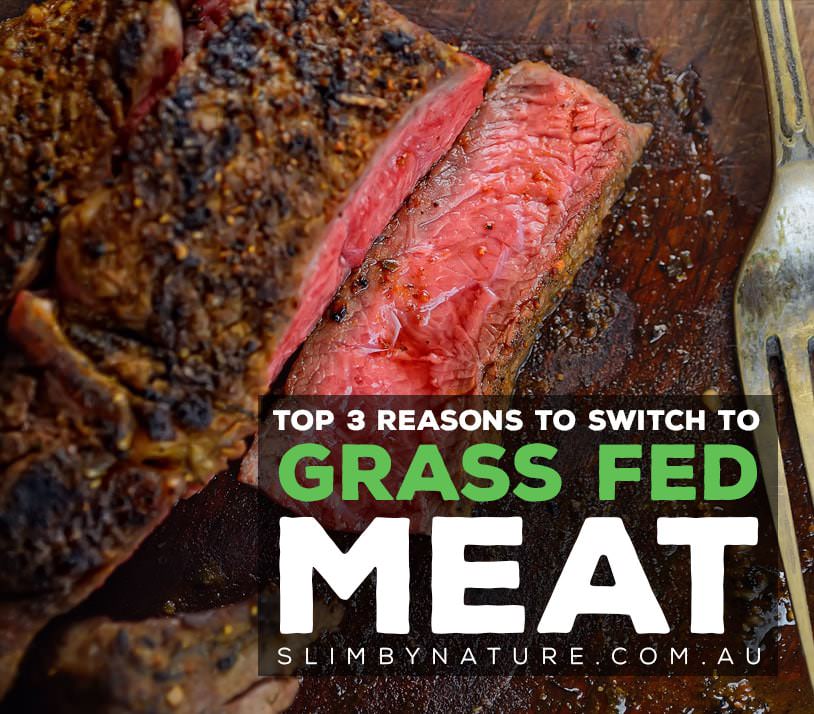What has become “normal” in ranching is to feed animals on grain, soy, growth hormones and antibiotics while keeping them in pens. They grow fast, bringing quicker profits for ranchers but the meat is not healthy. Because of the health problems caused by meats, some farmers now allow their animals to live on grass, their natural diet. The farmers do not treat their livestock with hormones or feed them growth-promoting additives. As a result, the animals grow at a natural pace. For these reasons and more, grass-fed animals live low-stress lives and are so healthy there is no reason to treat them with antibiotics or other drugs. Here are three reasons why you may want to consider eating grass fed meats.
1. Meats from grass fed cattle, sheep and bison are lower in fat and calories.
A piece of grass fed meat may contain one third as much fat as a similar cut from a grain fed animal. Fat has 9 calories per gram, compared with only 4 calories for protein and carbohydrates. The greater the fat content, the greater the number of calories. As an example, a 6-ounce steak from a grass-finished steer can have 100 fewer calories than a 6-ounce steak from a grain-fed steer. If you eat a typical amount of beef (66.5 pounds a year), switching to lean grass fed beef will save you 17,733 calories a year—without requiring any willpower or change in your eating habits.
2. Grass fed meat has 2 to 4 times more omega-3 fatty acids than grain fed meat.
The reason is that Omega-3s are formed in the chloroplasts of green leaves and algae which the animals and chickens eat on pasture. Sixty percent of the fatty acids in grass are omega-3s. Omega-3s play a major role in the cells and in every system in the body. Omega-3s are heart friendly, they are essential for the brain and may reduce risks of developing cancer. People with a diet rich in omega-3s are less likely to suffer from depression, schizophrenia, attention deficit disorder (hyperactivity), or Alzheimer's disease.
3. Grass fed meats are the richest source of conjugated linoleic acid, CLA.
If animals are raised on fresh pasture alone, they contain 3 to 5 times more CLA than meats from pen-fed grain-fed animals. CLA may be one of our most potent defences against cancer. In a study in Finland, women who had the highest CLA in their diet had a 60% lower risk of breast cancer than those with the lowest levels. Tilak Dhiman, a researcher from Utah State University estimates a person can lower the risk of cancer by eating the following products from grain-fed animals daily: one glass of whole milk, one ounce of cheese, and one serving of meat. In order to get the same benefit from grain fed products, you have to eat five times as much.
1. Meats from grass fed cattle, sheep and bison are lower in fat and calories.
A piece of grass fed meat may contain one third as much fat as a similar cut from a grain fed animal. Fat has 9 calories per gram, compared with only 4 calories for protein and carbohydrates. The greater the fat content, the greater the number of calories. As an example, a 6-ounce steak from a grass-finished steer can have 100 fewer calories than a 6-ounce steak from a grain-fed steer. If you eat a typical amount of beef (66.5 pounds a year), switching to lean grass fed beef will save you 17,733 calories a year—without requiring any willpower or change in your eating habits.
2. Grass fed meat has 2 to 4 times more omega-3 fatty acids than grain fed meat.
The reason is that Omega-3s are formed in the chloroplasts of green leaves and algae which the animals and chickens eat on pasture. Sixty percent of the fatty acids in grass are omega-3s. Omega-3s play a major role in the cells and in every system in the body. Omega-3s are heart friendly, they are essential for the brain and may reduce risks of developing cancer. People with a diet rich in omega-3s are less likely to suffer from depression, schizophrenia, attention deficit disorder (hyperactivity), or Alzheimer's disease.
3. Grass fed meats are the richest source of conjugated linoleic acid, CLA.
If animals are raised on fresh pasture alone, they contain 3 to 5 times more CLA than meats from pen-fed grain-fed animals. CLA may be one of our most potent defences against cancer. In a study in Finland, women who had the highest CLA in their diet had a 60% lower risk of breast cancer than those with the lowest levels. Tilak Dhiman, a researcher from Utah State University estimates a person can lower the risk of cancer by eating the following products from grain-fed animals daily: one glass of whole milk, one ounce of cheese, and one serving of meat. In order to get the same benefit from grain fed products, you have to eat five times as much.






Comment (1)
I may need your help. I’ve been doing research on gate io recently, and I’ve tried a lot of different things. Later, I read your article, and I think your way of writing has given me some innovative ideas, thank you very much.